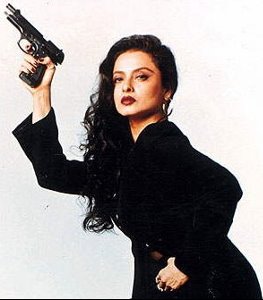

Although a recurring character in Bollywood film the Vamp/Moll has nonetheless come more to the fore in recent times. This is reflected by the Queen of Bollywood Aishwari Rai playing such a character in Khakee but she is not alone. In Bollywood film it used to an unwritten convention that the bad girl obtained some form of redemption before having to pay the price for her previous sins. However in Qayamat this convention was thrown out of the rule book and the villainess suffered the same fate as her fellow terrorists. The similar lack of redemption of the bad girl in the very popular spy-comedy Baadshah (1999) is also an indication that times have changed . Here the vamp (Deepshika) remains impervious to the charms of the heroes and remains so until her capture. A few years earlier it is likely that she would have turned to the path of the good and narrow and possibly suffered a horrible fate when the main villain learns of the change of heart. Baadshah is far too slight a film and Rani (Deepshika) far too jokey and minor a character for it to be significant on the progression of the Vamp but it is an interesting example of roles being redrawn.

A good example of the fate of the bad girl is illustrated in the film Himmat. The main vamp/villainess (Shilpa Shetty) is at first the seductive villainess to the film's heroes. Half way through the film she switches sides and works to save the hero. As a reformed bad girl her necessary fate is to be killed by the villain and this is duly done. Later on in the film another villainess (albeit an extremely minor character) is killed quite cold bloodedly by the hero during a chase scene. Once again the rules have been obeyed, the redeemed vamp can be killed by the villain and the unredeemed vamp girl can be killed by the hero.

Despite popular opinion Bollywood is not all singing, dancing and big stars. The output of the Bombay based film industry is quite phenomenal and it is quite understandable that there is a strong B movie industry. I would argue that, like the Hollywood B movie industry of the 1940's and 1950's, these lesser films do not have to play to the sensitivities of the Indian audiences and allow a grittier and darker vamp to be portrayed, often challenging the traditional male criminal to the limit. Among those worthy of mention are Aankhen (1993) where Reetu Shivpuri played a gun toting moll/bank robber in the mold of Brigitte Neilsen in Beverly Hills Cop 2. Others include Aag Hi Aag with Tina Munim playing a moll/assasin, Janasheen with Kashmira Shah playing a motor cycle gun moll hidden under some pretty grotesque make up and Benaam with another moll/assassin.

Certainly the characters have become more forceful and occasionally get elevated to being the chief protagonist - once again this trait is more visible in the Bollywood B movie and in Lollywood. One interesting actress who has taken on riskier roles is veteran actress Rekha. Rekha has been a star in Indian film for some time. In the middle part of her career she was sometimes cast as a super criminal with few redeeming factors. Maybe she was forced into these roles as her ability to play the young heroine waned and it has to be said some of her roles during this stage of her career were excruciatingly bad. In the very poor Madam X she played a super criminal and the woman sent to impersonate her. Though the film was pretty awful (though it wasn't a strain for me to sit through it) it did show that women were at least being considered as capable of supporting such roles. She also played a criminal mastermind in Kiladiron da Khiladi. The film was less fantastic than Madam X and a stronger effort. It seems unlikely that any other actress at that time would consider either role and it was some credit to her that she took the roles and gave them her best effort despite severe shortcomings in the films themselves.

The most traditional depiction of the vamp in Indian cinema equates to the femme fatale in western cinema. In the past this has largely meant that the vamp has acted as a distraction to the progress of the hero most notably by romantic liaison with the hero or a usurpation of his relationship with the heroine. In the western noir genre of the 1940's and the B movies of the 1950's the ultimate betrayal was the attempted murder of the hero by the femme fatale. It is not surprising then that western plot lines have been borrowed when films of this nature are made in India. Jism (starring Bipasha Basu again) is a prime example of noir iconology making its way in to Indian film. The plotline is borrowed from noir classics such as The Postman Always Rings Twice and Double Indemnity where the wife convinces her lover to kill her husband. Somewhere, something was lost in the translation but Bipasha positively smolders throughout the film until the denouement. Another noir type vamp named Julie was portrayed by Reetu Shivpuri in Aar Ya Paar. Far removed from her gunwoman/henchwoman role in Aankhen this lady is more akin to the Bipasha Basu role in Jism. However Reetu does not have the same innate sexiness as Ms Basu so you never really believe her character, who in the early stages of the film is a rather plain looking glass wearing woman, has the required charm and guile to persuade her lover to kill his wife. The story is actually taken from an obscure writer of cheap thrillers (James Hadley Chase) and the B movie feel of the movie has the B Book feel of the source material.
